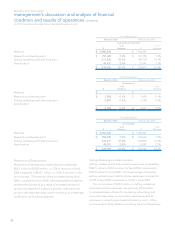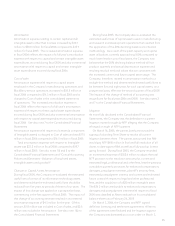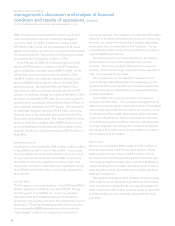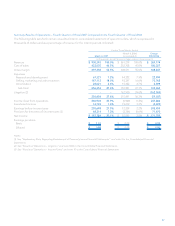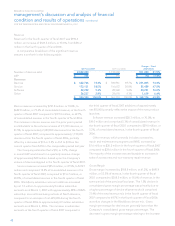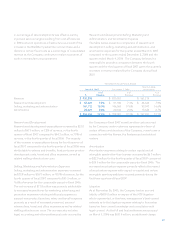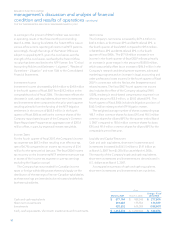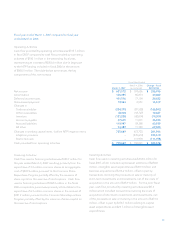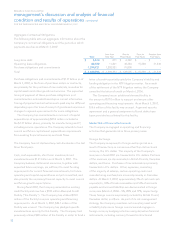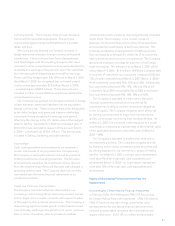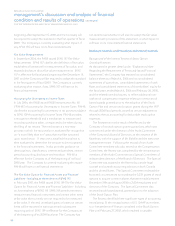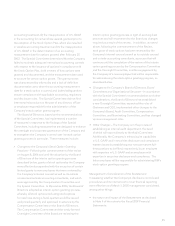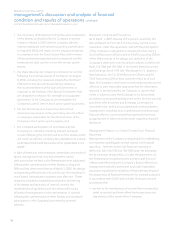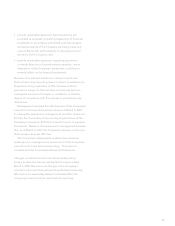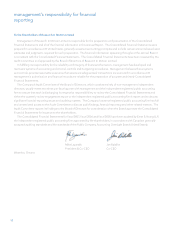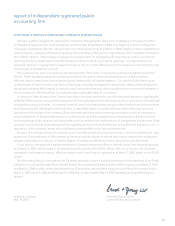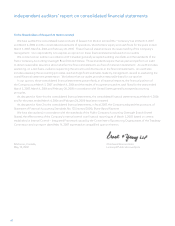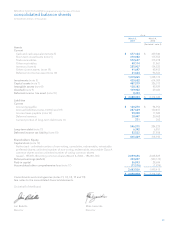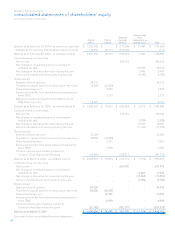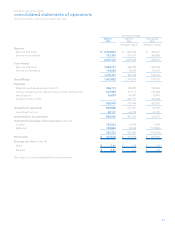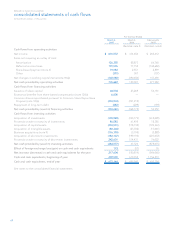Blackberry 2007 Annual Report Download - page 56
Download and view the complete annual report
Please find page 56 of the 2007 Blackberry annual report below. You can navigate through the pages in the report by either clicking on the pages listed below, or by using the keyword search tool below to find specific information within the annual report.54
RESEARCH IN MOTION LIMITED
management’s discussion and analysis of financial
condition and results of operations continued
FOR THE THREE MONTHS AND FISCAL YEAR ENDED MARCH 3, 2007
beginning after September 15, 2006 and the Company will
be required to adopt the standard in the first quarter of fiscal
2008. The Company is currently evaluating what impact, if
any, SFAS 155 will have on its financial statements.
Fair Value Measurements
In September 2006, the FASB issued SFAS 157 Fair Value
Measurements. SFAS 157 clarifies the definition of fair value,
establishes a framework for measurement of fair value, and
expands disclosure about fair value measurements. SFAS
157 is effective for fiscal years beginning after December 15,
2007 and the Company will be required to adopt the standard
in the first quarter of fiscal 2009. The Company is currently
evaluating what impact, if any, SFAS 157 will have on its
financial statements.
Accounting for Uncertainty in Income Taxes
In July 2006, the FASB issued FASB Interpretation No. 48
(“FIN 48”) Accounting for Uncertainty in Income Taxes. FIN 48
clarifies the accounting for uncertainty in tax positions subject
to SFAS 109 Accounting for Income Taxes. FIN 48 provides
a recognition threshold and a mechanism to measure and
record tax positions taken, or expected to be taken during
the filing of tax returns. The mechanism is a two-step
process in which the tax position is evaluated for recognition
on “a more likely than not” basis that it will be sustained
upon examination. If step one is satisfied the position is
then evaluated to determine the amount to be recognized
in the financial statements. It also provides guidance on
derecognition, classification, interest and penalties, interim
period accounting, disclosure and transition. FIN 48 is
effective for the Company as of the beginning of its fiscal
2008 year. The Company is currently evaluating the impact
FIN 48 will have on its financial statements.
The Fair Value Option for Financial Assets and Financial
Liabilities - Including an Amendment of SFAS 115.
In February 2007, the FASB issued SFAS 159 The Fair Value
Option for Financial Assets and Financial Liabilities - Including
an Ammendment of SFAS 115. SFAS 159 permits entities to
measure many financial instruments and certain other items
at fair value that currently are not required to be measured
at fair value. If elected, unrealized gains or losses on certain
items will be reported in earnings at each subsequent
reporting period. SFAS 159 is effective for the Company as
of the beginning of its 2009 fiscal year. The Company has
not determined whether it will elect to adopt the fair value
measurement provisions of this statement, or what impact it
will have on its consolidated financial statements.
Disclosure Controls and Procedures and Internal Controls
Background of the Internal Review of Stock Option
Granting Practices
As discussed in greater detail under “Explanatory Note
Regarding the Restatement of Previously Issued Financial
Statements”, the Company has restated its consolidated
balance sheet as of March 4, 2006 and its consolidated
statements of operations, consolidated statements of cash
flows and consolidated statements of shareholders’ equity for
the fiscal years ended March 4, 2006 and February 26, 2005,
and the related note disclosures, to reflect additional non-
cash stock compensation expense relating to certain stock
based awards granted prior to the adoption of the Stock
Option Plan and certain stock option grants during the 1997
through 2006 fiscal periods, as well as certain adjustments
related to the tax accounting for deductible stock option
expenses.
The Restatement is the result of the Review by the
Company of its stock option granting practices, which was
commenced under the direction of the Audit Committee
of the Company’s Board of Directors, at the initiative of Mr.
Kavelman, with the support of Mr. Balsillie and the executive
management team. Following the recusal of two Audit
Committee members who also served on the Compensation
Committee, the Review was completed by the remaining two
members of the Audit Committee as a Special Committee of
independent directors of the Board of Directors. The Special
Committee was assisted in the Review by outside legal
counsel and outside accounting advisors in both Canada
and the United States. The Special Committee reviewed the
facts and circumstances surrounding the 3,231 grants of stock
options to acquire common shares that were made between
December 1996 and August 2006 to 2,034 employees and
directors of the Company. The Special Committee also
reviewed stock-based awards granted prior to the adoption
of the Stock Option Plan.
The Review identified three significant types of accounting
errors being: (1) the misapplication of U.S. GAAP as it relates
to a “net settlement” feature contained in the Stock Option
Plan until February 27, 2002, which resulted in variable


